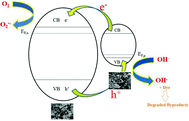Enhanced photocatalytic degradation of congo red by solvothermally synthesized CuInSe2–ZnO nanocomposites†
Abstract
Efficient photocatalysts of CuInSe2–ZnO nanocomposites were prepared via a solvothermal method using a mixed solvent of ethylenediamine and ethanol (volumetric ratio of 1 : 1). The products were characterized by SEM, EDX, XRD, PL, BET surface area, PZC and DRS UV-vis techniques and used for photo-degradation of congo red. The characterization results showed that crystallite size, BET surface area and optical absorption of the samples varied significantly with the addition of CuInSe2 to ZnO. The nanocomposites show absorption edges in the ultraviolet and visible regions depending on their CuInSe2 content. The optical band gap values of these nanocomposites were calculated to be about 3.37–2.1 eV, which show a red shift from that of pure ZnO. These red shifts indicate the incorporation of CuInSe2 in the zinc oxide lattice. In the investigation of the photocatalytic activity of the samples, the effects of the experimental parameters including pH, congo red concentration, CuInSe2 content and irradiation sources of UV and visible light have also been studied. Addition of CuInSe2 was effective in improving the photocatalytic activity remarkably. The highest percentage removals of 99.8% and 80.3% are observed for the photocatalyst containing 10 wt% CuInSe2 after 90 and 120 min under UV and visible irradiation, respectively. Also, a possible removal mechanism of the samples is proposed. It could be considered as a promising photocatalyst for dye degradation.


 Please wait while we load your content...
Please wait while we load your content...